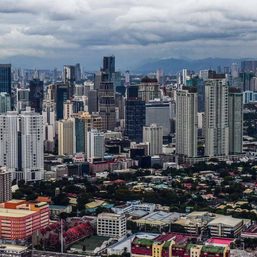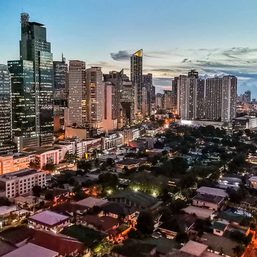SUMMARY
This is AI generated summarization, which may have errors. For context, always refer to the full article.

The Philippines is now facing its worst economic crisis in recent history, and President Rodrigo Duterte would need to spend to shore up the economy and save lives.
But his team is holding off on unleashing the fiscal stimulus bazooka despite the historic recession triggered by the coronavirus pandemic.
Gross domestic product (GDP) contracted by 16.5% in the 2nd quarter of 2020, the steepest crash on record. This is equivalent to some P820 billion knocked off from the economy largely due to the virus.
The proposed fiscal stimulus package the economic team is backing? P140 billion.
What Duterte’s team is saying
Finance Secretary Carlos Dominguez III reiterated that “whatever stimulus package we have, it has to be affordable and it has to recognize the fact that this COVID virus may not be defeated by the end of this year.”
“We have to keep our powder dry for next year as well,” he added.
Dominguez has supported the Senate’s Bayanihan 2 proposal, which seeks to inject P140 billion into the economy.
He went on to claim that the stimulus package would reach P180 billion, should the bill to lower corporate income taxes by 5% push through.
With lower corporate income taxes, said Dominguez, businesses would “get” P40 billion in tax credits. But other experts do not agree with this view, adding that a tax cut is not a stimulus measure.
Subsequent responses will be covered by the P4.5-trillion national budget for 2021, according to Dominguez.
Over in the House of Representatives, a massive P1.3-trillion stimulus package is being proposed.
Acting Socioeconomic Planning Secretary Karl Chua, who used to be Dominguez’s finance undersecretary, has already thumbed down the proposal, insisting that it is “not fundable.”
What economists are saying
Economists, the business community, and even lawmakers from both chambers are for the House version’s substantially bigger proposal.
Nicholas Mapa of ING Bank Manila is “hopeful for a substantial fiscal rescue effort to spearhead the economic recovery as the rest of the economy remains in sick bay. Down on its knees and bloodied, the Philippine economy must muster a 2nd half comeback to be remembered.”
Mapa earlier noted that the central bank, which has flooded the financial system with cash and lowered interest rates, needs its “dance partner” on the fiscal side.
Euben Paracuelles of Nomura Holdings said in a Bloomberg article that “this is likely to be the worst economic contraction across regional peers, and should serve as a huge wake-up call to fiscal authorities that a support package needs to be urgently implemented with a size that is more comparable to what we see in other countries.”
Michael Ricafort of Rizal Commercial Banking Corporation said the “lack of funding for new fiscal/economic stimulus measures could also lead to slower economic recovery and relatively tempered price pressures/limited inflation, going forward, thereby could also potentially increase the need for more monetary easing measures, as the economy may need these most at this time.”
Alex Holmes of Capital Economics said “a failure to contain the virus, continued restrictions to movement, and inadequate policy support mean the Philippines is also likely to experience one of the region’s slowest recoveries.”
Think tank IBON Foundation said that “knowing how stingy this amount is, they even deceitfully bloat this by claiming P40 billion in corporate tax breaks under the proposed Tax Reform for Acceleration and Inclusion (TRAIN) 2 aka Corporate Recovery and Tax Incentives for Enterprises (Create) Act as a stimulus measure.”
Stella Quimbo, economist-turned-Marikina 2nd District representative, earlier told Rappler that P140 billion is “a pitiful response to the biggest economic catastrophe since the World War.”
Ronald Mendoza, dean of the Ateneo School of Government, earlier told Rappler that Duterte has sufficient fiscal space to borrow some more.
He added that amid the economic and health crisis, Duterte’s attacks on corporations have dampened investor sentiment.
“Addressing COVID-19 and stabilizing investor jitters is difficult enough without these populist theatrics,” Mendoza said.
Alvin Ang, director of the Ateneo Center for Economic Research and Development, said the “recovery needs to align economy with clear health protocols to minimize impact of lockdowns.”
By the numbers
The country’s debt relative to the economy’s size, as seen through the debt-to-GDP ratio, is just a little over 39%, much lower than most regional peers and even developed nations. In a nutshell, the Philippines has enough elbow room to borrow. (READ: Duterte’s coronavirus loans and why PH might need more)
It is projected to hit 50% in 2020, still lower than much of the world.
World Bank economist Rong Qian earlier noted there is no magic number to determine the threshold multilateral lenders are comfortable with. But she said that “maybe 60%” could test the limits.
As for the budget gap, it is projected to now reach 9.6% of GDP in 2020, as the government foresees less tax collections and revenues due to the recession.
Dominguez said the Philippines is looking to borrow P3 trillion for 2021, the same level as 2020. This would be lowered to P2.3 trillion by 2022. 75% would come from domestic sources, while 25% would be from abroad.
In Southeast Asia, the Philippines ranks as the 4th country with the smallest coronavirus economic response in terms of share of GDP. (READ: PH’s economic stimulus vs coronavirus among lowest in the region)
Based on available data from the Asian Development Bank, the per capita distribution of the total coronavirus packages launched by the Philippine government ($197) so far also trails behind smaller Southeast Asian economies, such as Brunei ($742) and Timor-Leste ($200). – Rappler.com
Add a comment
How does this make you feel?


![[Time Trowel] Evolution and the sneakiness of COVID](https://www.rappler.com/tachyon/2024/02/tl-evolution-covid.jpg?resize=257%2C257&crop=455px%2C0px%2C1080px%2C1080px)


![[Vantage Point] Joey Salceda says 8% GDP growth attainable](https://www.rappler.com/tachyon/2024/04/tl-salceda-gdp-growth-04192024.jpg?resize=257%2C257&crop_strategy=attention)
![[In This Economy] Looks like PH economy will never get back on track. Here’s the data.](https://www.rappler.com/tachyon/2024/02/20240202-PH-economy-back-on-track.jpg?resize=257%2C257&crop=289px%2C0px%2C720px%2C720px)

![[In This Economy] Something’s broken, and it’s hidden by ‘high’ economic growth](https://www.rappler.com/tachyon/2023/11/something-broken-hidden-economic-growth-November-10-2023.jpg?resize=257%2C257&crop=276px%2C0px%2C720px%2C720px)

There are no comments yet. Add your comment to start the conversation.